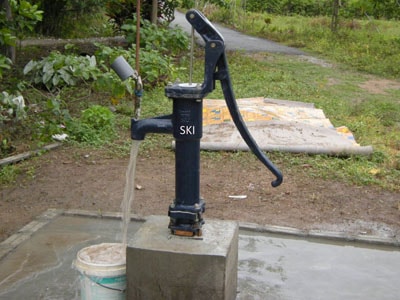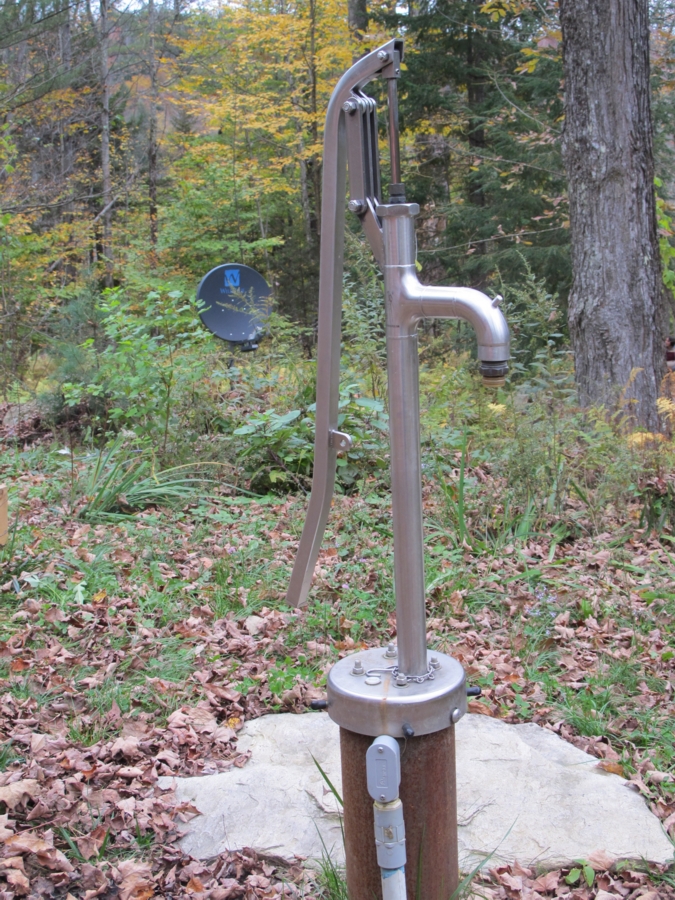Unconfigured Ad Widget
Collapse
|
|
|
|
|
|
|
|
How to draw water from a deep well in a no-power situation
Collapse
X
-
-
The casing should go to the bottom of the well? Static water at 40 feet with a well over 400 makes no sense? If your pump is at 400 feet it's not a small job to pull it .
My well is 125 feet deep with a static water level of 60 feet (surface water can be as high as 10 feet this not good drinking water) I can pull my pump with a A frame and the tractor in about 15 minutes with the help of one person so I have smaller pump that can swapped out easily.Comment
-
-
Short term- a generator is fine and at 1hp, you wont need a big one
long term- a generator is fine, keep some extra fuel around
end of the world, never getting power or fuel again- those old antique pumps were invented for a reason

The pump itself is at the bottom of the pipe, only the spout and handle are up above ground. Its hard as hell to suck water up 40', but pushing a 40' column of water only takes about 17 PSI

There are more modern options avaliable to make the pumping faster and easier than the antique iron pumps

Depending on the size of your casing and current well pump and plumbing, you might be able to install the hand pump side by side as you can see in the pic above- electric conduit for the main well with the manual well installed as backup. If they wont fit together you will have to lift and remove the old well pump one piece of pipe at a time, then assemble and lower the hand pump one pipe and op-rod section at a time.Rightful liberty is unobstructed action according to our will within limits drawn around us by the equal rights of others. I do not add 'within the limits of the law' because law is often but the tyrant's will, and always so when it violates the rights of the individual.
Thomas JeffersonComment
-
Your numbers are a little confusing. I think your static water level is actually 385 feet, not 40. The definition of static level is how far below ground the water level is in the well. If you have 40 feet of water in the well, measured from the bottom, that puts the surface of the water at 385 foot deep. This is the elevation you have to overcome when you pump water.
Based on the depth of your well, you probably have a 220 volt well pump so a back-up generator would have to supply 220. It sounds like your well pump goes directly into the pressure tank. This means your well has to power up every time you consume the volume of your pressure tank. Most pressure tanks hold about 50 to 80 gallons so I suspect your well pump is cycling frequently.
An above ground water storage tank (3,000 to 5,000 gallons) is a popular method to make your well pump use more efficient. Use your well pump to pump into a large holding tank, then use a more efficient 110 volt booster pump to fill your pressure tank from the nearby 3,000+ gallon storage tank.
This way, when water level in your storage tank drops by about 25%, a float switch triggers the well to come on until the water level in the storage tank is topped off. You pressure tank, meanwhile, draws water from the storage tank using a less power hungry, small booster pump to keep the pressure tank topped off.
The above ground storage tank allows you to use a much smaller generator to run the booster pump and pressure tank end of your system while you wait for the grid power to be restored to run your well pump to top off your large storage tank. I hope you were able to follow all of that. It can get confusing if you're not familiar with all these components.
I run my water system totally off grid. With two, 3,000 gallon water storage tanks, I don't have to worry about pumping water from the well after a string of cloudy days where my battery capacity may be running low. I just top off the storage tanks on sunny days. A small, energy efficient booster pump (made by Dankhoff) draws from the storage tanks and keeps my 80 gallon pressure tank ready to supply the household water needs 24/7.
My well is 140' deep with the static level at 80' below the surface. I use a solar powered, Grundfos AC/DC high efficiency pump that pumps at about 10gpm using just under 500 watts into my two 3,000 gallon storage tanks. A float switch is set to call for water when the storage tanks drop by about 15% of capacity. I don't use much water but my storage tanks give me reserve capacity and reaction time if something goes wrong with the well or well pump.
There are many ways to manage a water system. No one solution is perfect. There are lots of things that have to be factored in. For my situation, I focused on efficiency and redundancy.Last edited by twinfin; 01-17-2020, 12:12 AM.Comment
-
Last edited by Jeepergeo; 01-19-2020, 7:46 AM.Benefactor Life Member, National Rifle Association
Life Member, California Rifle and Pistol AssociationComment
-
A wise and well seasoned man with his winning solution!! Kudos SirYour numbers are a little confusing. I think your static water level is actually 385 feet, not 40. The definition of static level is how far below ground the water level is in the well. If you have 40 feet of water in the well, measured from the bottom, that puts the surface of the water at 385 foot deep. This is the elevation you have to overcome when you pump water.
Based on the depth of your well, you probably have a 220 volt well pump so a back-up generator would have to supply 220. It sounds like your well pump goes directly into the pressure tank. This means your well has to power up every time you consume the volume of your pressure tank. Most pressure tanks hold about 50 to 80 gallons so I suspect your well pump is cycling frequently.
An above ground water storage tank (3,000 to 5,000 gallons) is a popular method to make your well pump use more efficient. Use your well pump to pump into a large holding tank, then use a more efficient 110 volt booster pump to fill your pressure tank from the nearby 3,000+ gallon storage tank.
This way, when water level in your storage tank drops by about 25%, a float switch triggers the well to come on until the water level in the storage tank is topped off. You pressure tank, meanwhile, draws water from the storage tank using a less power hungry, small booster pump to keep the pressure tank topped off.
The above ground storage tank allows you to use a much smaller generator to run the booster pump and pressure tank end of your system while you wait for the grid power to be restored to run your well pump to top off your large storage tank. I hope you were able to follow all of that. It can get confusing if you're not familiar with all these components.
I run my water system totally off grid. With two, 3,000 gallon water storage tanks, I don't have to worry about pumping water from the well after a string of cloudy days where my battery capacity may be running low. I just top off the storage tanks on sunny days. A small, energy efficient booster pump (made by Dankhoff) draws from the storage tanks and keeps my 80 gallon pressure tank ready to supply the household water needs 24/7.
My well is 140' deep with the static level at 80' below the surface. I use a solar powered, Grundfos AC/DC high efficiency pump that pumps at about 10gpm using just under 500 watts into my two 3,000 gallon storage tanks. A float switch is set to call for water when the storage tanks drop by about 15% of capacity. I don't use much water but my storage tanks give me reserve capacity and reaction time if something goes wrong with the well or well pump.
There are many ways to manage a water system. No one solution is perfect. There are lots of things that have to be factored in. For my situation, I focused on efficiency and redundancy.Comment
Calguns.net Statistics
Collapse
Topics: 1,857,045
Posts: 25,027,147
Members: 354,385
Active Members: 6,367
Welcome to our newest member, JU83.
What's Going On
Collapse
There are currently 3309 users online. 175 members and 3134 guests.
Most users ever online was 65,177 at 7:20 PM on 09-21-2024.


Comment